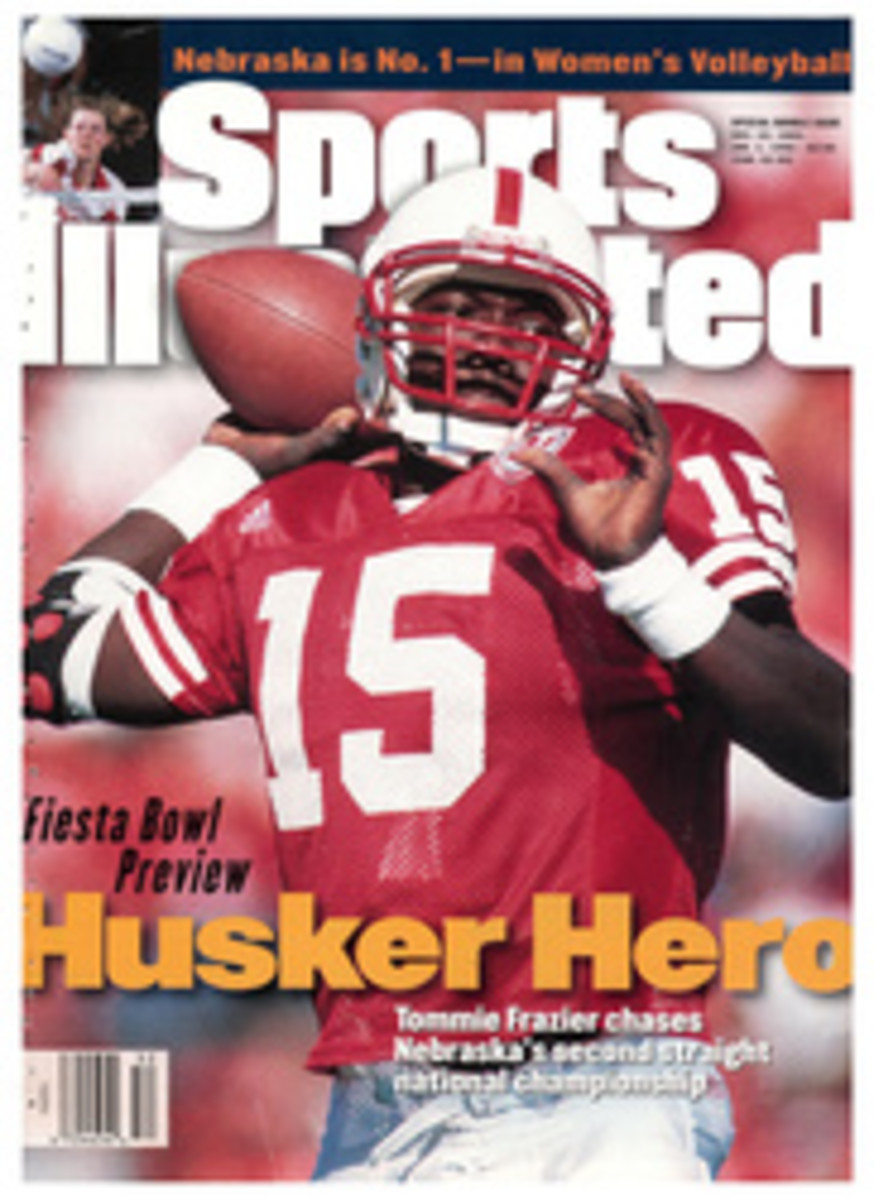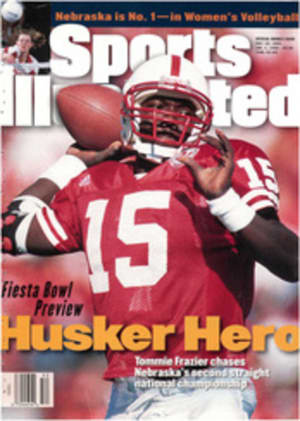
PET PEEVE NEBRASKA LINEBACKER JARED TOMICH HAS SOME TROUBLE WITH WORDS, BUT HE CERTAINLY CAN SPEED-READ THE OPPOSING TEAM'S QUARTERBACK
Jared Tomich, an All-America outside linebacker for the Nebraska
Cornhuskers, lives two miles from campus in a mobile-home park
called Countryside Estates with his iguana, his girlfriend and
their cat. Their mobile home consists of a kitchen, a living
room with a TV, a narrow hallway and two bedrooms, but the cozy
dwelling might as well be a library, for all the studying Tomich
does in it. He happily studies game tapes for hours at a time;
his fascination with how a single down unfolds is limitless. He
spends even more time with the texts from his classes, but this
work is not as effortless. Tomich has a learning disability
called attention-deficit disorder. Retaining information
acquired through reading is a monstrous task for him. When he
tries to concentrate on numbers or written words, his mind is
bombarded with stray thoughts.
For pictures, though, he has a certain genius.
"This is third-and-14, so you know 90 percent of the time
they're going to pass," Tomich says. He's watching a tape of
Nebraska's season opener, a 64-21 victory over Oklahoma State,
and preparing for the final game of the campaign, against
Florida in the Fiesta Bowl on Jan. 2. "The ball is snapped, and
I realize they've double-teamed me. All I want to do is get to
the quarterback, so with my right hand I push the tight end into
the tackle. My left arm is flailing. Then I see this flash--the
quarterback--and I get my left arm around him and pull him down.
I'm feeling jubilant. I start to raise my arms, but I put them
down fast. They're cracking down on displays of celebration.
That was my first sack of the year. My goal was 10 sacks, and
that's what I got."
Tomich (his Croatian name is pronounced TOM-ich) is an immense
man of 21 years with a 2.3 grade point average and a lively
vocabulary. (He routinely uses words such as flailing and
jubilant.) He plans to play for the Cornhuskers next year, as a
fifth-year senior, then make himself available for the NFL
draft. If he continues on his current path, if he becomes bigger
and stronger and faster, he could be a first-round pick. (He's
already 6'2" and weighs 260 pounds; he bench-presses 400 pounds
and runs the 40-yard dash in 4.83 seconds.) He looks like a
professional linebacker already. His ears barely protrude from
his shaved head, no part of which is wider than his neck. But
he's not in any rush for the pros. One more year at Nebraska, he
figures, will do wonders for him as a football player and as a
student.
On a school night earlier this month, Tomich sat in his home and
explained to a visitor how a college football player becomes a
professional. Phil, the iguana, and Flea, the cat, were among
his listeners. So was Lisa Walczak, his girlfriend. They went
together to their high school prom in St. John, Ind.
"In May they have this combine, and all the college players go
there and get tested for strength and speed and stuff, then in
April they have the draft, and then you negotiate with the team
that drafts you," Tomich said.
"Wouldn't they have the combine first, then the draft?" the
visitor offered. For a moment, Tomich appeared confused.
"May comes after April," said Walczak, gently.
Tomich made a quick nod of recognition and said, "I mean March.
The combine's in March, then the draft." (In fact, the combine
is usually in February.)
Some tasks that are simple for most people are complex for
Tomich. Trying to understand the boundaries of his mind, the
visitor asked him to multiply nine times seven. "Let me think
for a minute," said Tomich, a communications major. "I haven't
done this for a while. Usually, I use a calculator." Two seconds
passed. "Sixty-three."
How did he arrive at the answer?
"I started counting by nines--9, 18, 27--and when I got to 27, it
just hit me," he said.
Tomich attended public school in St. John, and in the third
grade he was placed in a class for learning-disabled students.
He could read, but his retention was poor. (Tomich has read only
a few books outside of the classroom, a favorite being You're
Okay, It's Just a Bruise, by Robert Huizenga, a former NFL team
physician.) Reading problems were something with which Jared's
parents were unfamiliar. His mother, Cheryll, who works in the
pet department of a store in St. John, is an avid reader, a
Stephen King buff. Jared's father, James, a big-machinery
mechanic at a steel mill in Gary, Ind., reads newspapers and
technical journals. But the school counselors said Jared was
learning-disabled, and his parents reasoned that the counselors
surely knew what they were talking about.
Some of Tomich's classmates had speaking difficulties, some had
physical abnormalities. Jared looked and sounded normal, but he
knew already what it took teachers a decade to figure out. His
mind worked for pictures, not for words.
On the Nebraska campus in Lincoln there's a museum called the
Sheldon Memorial Art Gallery, and Tomich paid his first visit to
it the other day. He examined an Andy Warhol painting with four
nearly identical images of Mickey Mouse; all Tomich could see
were the differences. He didn't want to guess the painting's
value. "I wouldn't want to insult the painter," he said.
Tomich had passed the museum hundreds of times in his four years
at school, but he was always due someplace else. In his first
year he was a compulsive student, trying to gain the academic
credentials necessary to qualify for an athletic scholarship. In
his second year (during which he practiced with the team but did
not play) Tomich and Walczak bought their home for $4,000, and
Tomich spent his limited free time fixing it up. Last year was
his first as both a full-time football player and a full-time
student. This year he was an important starter on the college
football team ranked highest in the nation, and that's
time-consuming.
Now that he was finally visiting the museum, he said, "This is
nice. It's tranquil."
Tomich looked at a painting of a stream in a woods and, moving
his lips, read an accompanying placard that gave the name of the
artist, the year he was born, the title of the work and the year
it was painted. "This I could see on the wall of my house," he
said.
The football player turned away from the painting. Several
minutes later he was asked what he remembered of it. His memory
was precise. He knew the painting's size. He recalled a leafless
limb straddling the stream. He had a sense of the painting
methods used by the artist. But the information on the placard
was gone from Tomich's mind.
"Every kid learns differently," says Charlie McBride, the
Cornhuskers' defensive coordinator and the man who got Tomich to
Nebraska when no other four-year college was prepared to take
him. "I don't know that I've ever had a player who studies tape
more intently. He likes to do it alone, at his own speed. If
some of the other kids come in to watch, he slips out."
When Tomich was a senior in high school, an Indiana coaches'
poll named him an all-state defensive end. But he made mostly
C's and D's in his classes, and when he took the Scholastic
Aptitude Test, he scored less than 600. Virtually every
recruiter looking at his transcript thought, Not college
material. Not NCAA Division I material, anyway. Some even
doubted his football skill. After his senior season, a recruiter
from Purdue got on the phone with Tomich one night and said,
"You're not talented enough to play for us." Tomich, a gentle
soul who channeled his classroom frustrations into
weightlifting, slammed down the receiver. "That was
devastating," Cheryll recalls. "He was in tears. I was in tears.
I wrote that man a letter. I let him have it."
In the road map of his mind, Jared changed directions. He
started to imagine himself working beside his father at the
steel mill. He figured his dream of playing big-time college
football was over.
Several months later, a stranger named Dick Peterson came to
Tomich's aid. Peterson was the strength coach at a rival high
school, East Chicago (Ind.) Central. He had seen Tomich on the
Lake Central football field and at weightlifting competitions.
He was impressed by Tomich's immense strength and resolve.
Peterson called his alma mater, Nebraska, and spoke to McBride.
"I said, 'He's a diamond in the rough,'" Peterson remembers.
"Coach McBride said, 'I'll take a look.'"
Tomich's transcripts made McBride nervous, but the speed and
strength revealed on the tapes of his high school games
persuaded him to press on. "I went to his school, I stopped a
kid in the hallway," McBride says. "The kid was a third-team
player. I asked him what Jared Tomich is like. He said, 'Jared's
one of the nicest guys on the team and one of the hardest
workers.' I went on from there. You could see Jared had
excellent values. You could see he had parents who cared. All he
wanted was a chance."
In March of his senior year, Tomich applied to Nebraska. A
teacher wrote a letter describing Tomich's learning disability,
and, under a special program for such students, Tomich took the
SAT with a proctor reading the questions and without a time
clock. He says he scored 860. He was admitted to Nebraska but
told he would have to take certain classes to make up for his
high school deficiencies. Upon arrival in Lincoln, Tomich took a
series of tests that gave a name to his learning problems:
attention-deficit disorder. The team doctor, in consultation
with university education specialists, gave Tomich a
prescription for Ritalin, a drug that is frequently given to
patients who are hyperactive or have ADD, but Tomich balked at
the idea of a drug that affected his mind and soon stopped
taking it. (Later, Jared's brother, Justin, now in eighth grade,
was found to have ADD and was given Ritalin for a year, Cheryll
says.)
Jared says he owes his current grade point average, at least in
part, to his girlfriend. Walczak, a criminal justice major,
frequently reads class texts aloud with Jared. Words spoken make
much more of an impression on Tomich than words he reads
silently. Images make the greatest impression of all.
Tomich has watched a great deal of tape of Florida football. He
has pictures in his mind of what the Gators do and pictures of
what he'll do in response. He has pictures beyond the Fiesta
Bowl, too. He imagines himself driving a reliable car. He
imagines himself spending vacations in a cabin on a lake with a
big sky above him and mountains all around. He liked the movie
The Swiss Family Robinson, loved how the family got by on
ingenuity, how it thrived without modern technology, without
written communication. "Those guys," Tomich says, "had it made."
COLOR PHOTO: BILL FRAKESPhil may be a mere reptile to most people, but to Lisa and Jared, he's a member of the family. [Lisa Walczak, Phil (the iguana), and Jared Tomich]
COLOR PHOTO: DOUG HOKE/THE DAILY OKLAHOMAN Tomich's takedown of the Sooners' Eric Moore helped him achieve his benchmark of 10 sacks for the season. [Jared Tomich sacking Eric Moore]
COLOR PHOTO: RICHARD MACKSON [See caption above--Jared Tomich sitting on bench]
COLOR PHOTO: BILL FRAKES This defense (from left: DT Christian Peter, Tomich, DT Jason Peter and OLB Grant Wistrom) is razor sharp. [Christian Peter, Jared Tomich, Jason Peter, and Grant Wistrom shaving their heads]

